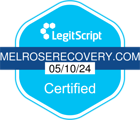What exactly does “evidence-based treatment” mean, and how does it work in practice? In recent years, this term has gained significant traction in the healthcare industry, particularly in fields like mental health and addiction recovery, where the right kind of care can make a huge difference in people’s lives. Essentially, an evidence-based treatment center uses scientifically validated methods to ensure patients receive the most effective care possible.
At Melrose Recovery, evidence-based treatment is at the heart of everything we do. Every method we use is backed by solid research and proven to help patients achieve a lasting recovery. From personalized therapy sessions to supportive group meetings, Melrose Recovery combines the latest findings in psychology and addiction science to create programs tailored to each person’s unique needs. By focusing on evidence-based methods, Melrose Recovery not only boosts the chances of successful recovery but also ensures that patients receive the highest standard of care on their journey to a healthier, sober life.
What is an Evidence-Based Treatment Center?
Evidence-based treatment (EBT) refers to therapeutic interventions and practices backed by scientific research and clinical evidence demonstrating their effectiveness. The history of EBT can be traced back to the early 20th century, but it gained significant momentum in the 1970s and 1980s with the rise of evidence-based medicine (EBM). EBM, pioneered by researchers like Archie Cochrane, emphasized the importance of using rigorous scientific methods to evaluate medical practices. The movement expanded to various fields, including psychology and education, leading to the broader adoption of EBT principles.
The key components of evidence-based treatment include:
- Research and clinical trials: EBTs are supported by rigorous scientific studies, including randomized controlled trials, meta-analyses, and systematic reviews, which provide strong evidence of their efficacy and safety.
- Best available evidence: Practitioners rely on the best current evidence from well-designed research studies when making treatment decisions.
- Clinical expertise: The clinician’s skills, knowledge, and experience play a crucial role in interpreting and applying research findings to individual patients.
- Patient values and preferences: EBTs take into account the preferences, values, and specific circumstances of patients, ensuring treatments are tailored to meet their unique needs and goals.
- Standardization: EBTs often involve standardized treatment protocols and guidelines to ensure consistency and reliability in clinical practice.
- Continuous evaluation: Treatments are continually evaluated and updated based on new research findings to maintain their effectiveness and relevance.
This comprehensive approach ensures that therapeutic interventions are both scientifically validated and personalized to the individual, optimizing the chances for successful outcomes in addiction recovery.
How Do You Know if a Treatment is Evidence-Based?

To determine if a treatment is evidence-based, follow these steps:
- Find peer reviewed sources. Look for studies published in reputable, peer-reviewed medical or scientific journals. These studies should involve rigorous research methods and be conducted by credible researchers.
- Check systematic reviews and meta-analyses. Systematic reviews and meta-analyses compile results from multiple studies, providing a comprehensive overview of the evidence. These reviews are often more reliable than single studies.
- Consult clinical guidelines. Refer to clinical guidelines from reputable health organizations (e.g., World Health Organization, American Medical Association). These guidelines are based on extensive research and expert consensus.
- Examine the study design. Prefer randomized controlled trials (RCTs) and other high-quality study designs over anecdotal evidence or case reports. RCTs are considered the gold standard for determining treatment efficacy.
- Assess the sample size and duration. Larger sample sizes and longer study durations typically provide more reliable results. Small or short-term studies may not capture the full effects of the treatment.
- Check for replication. Treatments replicated in multiple studies by different researchers are more likely to be reliable. Consistency in findings across various studies strengthens the evidence.
- Review conflict of interest statements. Ensure the research is free from conflicts of interest. Studies funded by organizations that might benefit from positive results should be scrutinized.
- Consult experts and professional organizations. Seek opinions from experts or professional organizations. They can provide insights into the treatment’s validity based on current evidence.
- Look for real-world evidence. Consider observational studies and real-world data that support the treatment’s effectiveness in broader, more diverse populations.
By following these steps, you can better determine if a treatment is evidence-based, ensuring it is supported by credible and reliable scientific evidence.
What are Examples of Evidence-based Treatment?
Evidence-based treatments are therapies and interventions that have been scientifically tested and proven effective through rigorous research. Here are some examples:
Used to treat a variety of mental health conditions, including depression, anxiety disorders, and PTSD. CBT focuses on changing negative thought patterns and behaviors. This helps patients shift their perspective and thought habits for long-term results.
The use of medications such as antidepressants, antipsychotics, and mood stabilizers to manage symptoms of mental health conditions like depression, schizophrenia, and bipolar disorder. These medications have been tested in clinical trials and have been shown to be effective. Treatment plans for medication management are catered to the individual.
Originally developed to treat borderline personality disorder, DBT combines CBT techniques with mindfulness strategies. It is also effective for treating conditions like eating disorders and chronic suicidal ideation. DBT focuses on mindfulness, distress tolerance, emotional regulation, and interpersonal effectiveness.
Commonly used for treating phobias, PTSD, and panic disorders, exposure therapy involves gradually exposing patients to the source of their anxiety. Doing so in a controlled environment may help reduce fear and avoidance behaviors. Under the supervision of a professional, this can help individuals build a tolerance for their phobias or triggers.
Motivational interviewing is a counseling approach that helps individuals find the motivation to make positive behavioral changes. It is often used in addiction treatment and health behavior changes. This client-centered approach helps individuals find ways to reduce stress in their lives.
This is a program that incorporates mindfulness meditation and yoga. The goal of mindfulness-based stress reductions is to help individuals manage stress, pain, and illness through holistic methods. MBSR has been shown to reduce symptoms of anxiety and depression.
ABA involves using techniques and principles to bring about meaningful and positive changes in behavior. It is often used for children with autism spectrum disorder. This therapy focuses on the recipient’s learning style as well, to help determine the best way to elicit a change in behavior.
EDMR therapy is used to treat PTSD and trauma-related disorders. It involves using guided eye movements to help individuals process and integrate traumatic memories. This can help them mediate negative emotions related to the memory.
These treatments are backed by research and have demonstrated effectiveness in controlled studies, making them reliable options for managing various health conditions.
Understanding Evidence-Based Treatment for Addiction
Evidence-based treatment (EBT) for addiction is a scientifically proven therapeutic approach designed to help individuals recover from substance abuse. It starts with a comprehensive assessment by healthcare professionals to evaluate the addiction’s severity, any co-occurring mental health disorders, and the individual’s overall health. Accurate diagnosis is essential as it guides the creation of a personalized treatment plan tailored to address all aspects of the individual’s condition.
Evidence-Based Treatment (EBT) focuses on personalized care, considering the type of substance, addiction severity, and the patient’s circumstances. Treatment often combines multiple therapies and includes Medication-Assisted Treatment (MAT) for opioid and alcohol dependencies. Medications like methadone, buprenorphine, and naltrexone help manage withdrawal and reduce cravings. EBT also emphasizes developing strong support systems (therapists, counselors, family, and friends) and includes relapse prevention strategies to identify triggers, develop coping mechanisms, and create sustainable lifestyle changes.
Treatment progress is continuously monitored, and plans are adjusted based on the individual’s progress and any new challenges. This dynamic approach ensures the treatment remains effective and responsive to the individual’s evolving needs. Successful recovery often requires ongoing support even after the initial treatment phase. Aftercare programs, including continued therapy, support groups, and sober living environments, help individuals maintain their sobriety and build a fulfilling life free from addiction.
Evidence-based Treatments at Melrose Recovery
At Melrose Recovery, we understand that overcoming addiction requires more than just determination; it demands evidence-based treatments tailored to each individual’s unique needs. As a leading evidence-based treatment center, our team of dedicated professionals employs scientifically validated methods to ensure the highest standards of care.
Are you or a loved one struggling with addiction? Take the first step towards a healthier, more fulfilling life. Contact us today to learn more about our evidence-based treatment programs.










